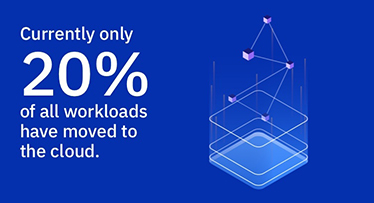The average business runs close to 2,000 custom workloads* in their legacy enterprise resource planning systems, yet more than 50 percent of those programs are never used. With 40,000 global consultants dedicated to platforms like SAP and Microsoft, IBM has first-hand knowledge of how to maximize the capabilities of these mission-critical systems.
Why shift workloads to the cloud?
Core business applications are more important than ever, from process planning to CRM (Customer Relationship Management). When this data becomes connected, real-time insights allow you to build a smarter business, make critical decisions, optimize investments to fund innovation and deliver essential customer experiences. While many enterprises begin their cloud journeys by migrating customer-facing applications to cloud-native applications, these only make up a fraction of the total applications run by enterprises.
Currently, only 20% of all workloads have moved to the cloud.

Cloud 2.0
In order to complete this digital transformation, organizations need to move to the second phase of cloud adoption, which is enabling and integrating cloud-native applications into hybrid multicloud environments. By bringing a hybrid cloud model to mission-critical applications, including front-office and back-office, your enterprise can work more effectively. You can gather customer, supply chain, sales and marketing data to deliver new services and applications to customers, employees, and partners. This multicloud approach will allow you to optimize your applications and match the right workloads to the right cloud providers, creating more efficient partnerships.
Three benefits of utilizing multicloud environments
The three main benefits of moving business-critical workloads to a multicloud environment are 1) greater scalability, 2) cost savings and 3) flexibility.